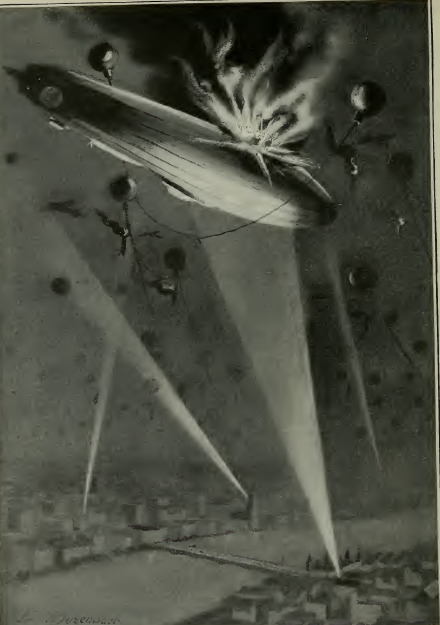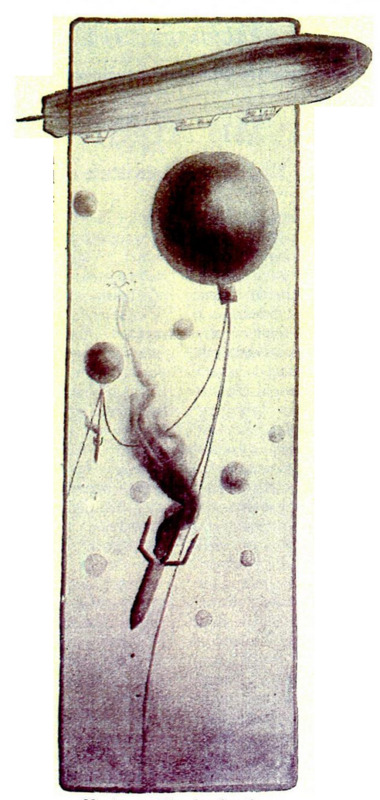Mining the Air
Contenuto
-
Titolo
-
Mining the Air
-
Article Title and/or Image Caption
-
Mining the Air Against Zeppelins
-
extracted text
-
THE failure of the English high-angle anti-aircraft artillery to destroy Zeppelins attacking London has heen repeatedly demonstrated, and it has stimulated many a scientific mind to invent some more efficient means of
defense. At night the English aeroplanes are at a serious disadvantage, since the glare of the ground searchlights renders it almost impossible to drop bombs on the enemy with go degree of accuracy. Instead, they fail into London, causing explosion and conflagration, The an exists in firing upward against the almost invisible ind swiftly moving’ Zeppelins.
Joseph Steinmetz, an American inventor, proposes to mine the air with bomb-carrying balloons. Small hydrogen balloons, connected in pairs or groups by piano wire (weighing “about ten pounds to the mile) are to be set adrift when the Zeppelins are over London, According to the inventor, they would rise rapidly and enmesh the enemy's aircraft. Attached to the balloon units are small hook-trigger bombs of high explosive contact and incendiary, torches, which are to be drawn into the Zeppelin's gas bag with destructive ‘results, The method is to be further elaborated by a nets of very wide mesh, an idea successfully applied in Submarine war. fare. In the opinion of Mr. Steinmetz, even though the chance of a Zeppelin fouling the balloon-connecting wires is only one in a thousand, that one chance is well worth the attempt and expense.
At first blush this scheme the air as a defense agains is attractively plausible. if the atmosphere above full of floating air-mines, it would not be so easy to bombard the town from aloft. When it comes to making this arrangement practical, however, serious difficulties are immediately encountered. Flotation in air is not like flotation in water. A balloon left to itself invariably goes up or comes down. It is generally considered a wonderful accomplishment if a balloonist knows the aerial ocean well enough to keep his craft in regions where sun, winds and vapors do not continually force it from its level, thus causing him to use up gas and ballast and shortening the trip. Over a great city, this procedure would be extremely hazardous. After the air has been thoroughly sown with mine-balloons, it may snow. Imagine the result! With a wind blowing the balloons about during a snow storm, and their bombs striking roofs right and left, the inhabitants of London might prefer the attacks of the Zeppelins. Think of the conflagation these clusters of balloons might cause! The whole plan harks back to the experiment made in Austrian campaign against Venice in 1849. Nothing was done by halves at that time, No less than two hundred small hydrogen balloons, each carrying a twenty-five or
thirty pound bomb, were liberated, but they refused to stay at the right level, They continued to rise until an upper current of opposite direction found t and returned them to the senders.
balloons must be many times larger than the heaviest floating mines, At short range they would furnish ideal targets to a Zeppelin’s machine-guns. A Zeppelin may easily shade its lights and yet clearly illuminate a near object in the air. Let a good marksman with a machine-gun be stationed at each side of the front car, and
before any balloon-mine could do any harm, it would be shot’ down and fall into a city street.
The Plan Is Feasible in Water Interconnecting cables such as Mr. Steimetz proposes are more satisfactory in water than in the air, where they are liable to slip off upward or downward. If caught by airships below them, the bombs will be drawn together harmlessly beneath the level of the hull. The chances are that the Zeppelin would gather a trailing mass of wires, empty balloons and live bombs in its wake, to be cut off for the benefit of those below. The steel propellers would cut the thin wire, and since they are as big and heavy, would hardly be damaged. It would also be easy to shape a Zeppelin so that single wire must slip off wherever it strikes the hull, simply by slanting the outlines of all pro-
Sweeping a Channel for Mines
THE operation of mine sweeping is one of the most dangerous and arduous of the many tasks that fall to the lot of a navy. The dangers of mine sweeping are great even in the North Sea and around the British Coasts, where there is no active opposition. These dangers are, of course, greatly increased when the ships are continually under fire, as they were in the Dardanelles.
A mine field consists of a number of mines laid together. It will most effectively block off any particular area of water. A certain number of mines are generally laid at intervals just deep enough to render them invisible to the look-out on board the mine sweepers, For such work shallow draught ships are always employed.
Mine sweepers work generally in pairs, Each ship tows over the stern a wooden apparatus called a kite, fitted with planes which dive beneath the water. The depth to which it dives is regulated by the speed of the
towing ship. Each of these kites is fitted with a pulley block. A wire Tope is passed from the stern of one ship through the pulley on its own late across the water through the block on the second kite and so up to the stern of the second
-
Autore secondario
-
Carl Dienstbach (writer)
-
Joseph A. Steinmetz (inventor)
-
Lingua
-
eng
-
Data di rilascio
-
1916-02
-
pagine
-
163-164
-
Diritti
-
Public Domain (Google digitized)
-
Archived by
-
Filippo Valle
-
Alberto Bordignon (Supervisor)



